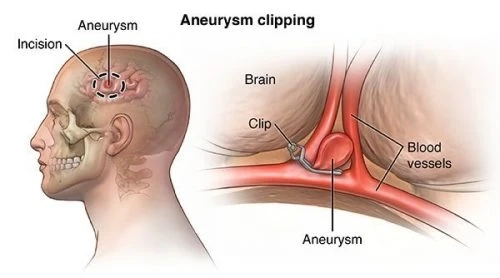Brain Aneurysms Overview:
Brain Aneurysms, also known as a cerebral aneurysm or intracranial aneurysm, is a bulging or ballooning in a blood vessel in the brain. This condition can be a serious and potentially life-threatening medical emergency. Understanding its symptoms, diagnostic methods, and treatment options is crucial for both patients and healthcare professionals.
The NIH reports that the global frequency of brain aneurysms is 3.2%, with a mean age of 50 and a gender ratio of 1:1 overall. This ratio significantly changes after the age of 50, with an increasing female predominance that gets close to a 2:1 ratio. This is thought to be brought on by a drop in estrogen levels in the blood, which reduces the quantity of collagen in vascular tissue. Subarachnoid hemorrhage (SAH) is caused by ruptures that occur about once per 100,000 people. There are higher rates of this in some populations than others, such as the Finnish and Japanese populations.
Diagnostic Market Players:
General Electric Company (GE Healthcare)TECHNOMACSiemens HealthineersMed Imaging SolutionsCanon Medical Systems CorporationGastro diagnostic.LtdRadiance Imaging systemFujifilm Holdings Corporation (FUJIFILM Medical Systems)OthersTreatment Market Player:
MedtronicIntegra LifeSciencesInfraScanMicroPort Scientific CorporationRenolitSpiegelbergJohnson & Johnson.StrykerBraun Melsungen AGTerumo CorporationMicrovention Inc.OthersSymptoms:
Brain aneurysms often do not show any symptoms until they rupture, causing a subarachnoid hemorrhage. Some warning signs may include severe headaches, nausea, vision changes, and neck pain. However, in many cases, aneurysms are asymptomatic until they pose a significant risk.
Diagnostic Analysis:
Advanced diagnostic techniques play a pivotal role in identifying and assessing brain aneurysms. Imaging studies, such as magnetic resonance angiography (MRA) and computed tomography angiography (CTA), are commonly employed to visualize blood vessels and detect aneurysms. Early detection is crucial for prompt intervention and prevention of rupture.
Get a Free Sample Research Report:
https://www.diseaselandscape.com/downloadsample/postid/120
Treatment Analysis:
The treatment approach for brain aneurysms depends on factors such as the aneurysm's size, location, and the patient's overall health. Options include surgical clipping and endovascular coiling. In surgical clipping, a small metal clip is placed around the neck of the aneurysm to prevent rupture. Endovascular coiling involves inserting a catheter into the blood vessel to place coils within the aneurysm, promoting blood clotting and reducing the risk of rupture.
Regulatory Framework:
The regulatory landscape governing the diagnosis and treatment of brain aneurysms varies globally. Health regulatory bodies in different countries set standards for medical devices, medications, and treatment protocols. Understanding and adhering to these regulations are crucial for healthcare providers and manufacturers in the development and delivery of effective aneurysm management.
Clinical Assessment:
Ongoing clinical research aims to enhance our understanding of brain aneurysms, improve diagnostic accuracy, and refine treatment approaches. Clinical trials explore new interventions, technologies, and medications that may contribute to better outcomes for patients. Collaboration between researchers, healthcare professionals, and regulatory authorities is essential in advancing the field.
Browse Full Insights:
https://www.diseaselandscape.com/neurodegenerative/brain-aneurysms-market-barriers
Market Trends Analysis:
The market for brain aneurysm diagnosis and treatment is dynamic, with constant advancements in technology and a growing emphasis on minimally invasive procedures. The demand for innovative imaging tools, surgical techniques, and therapeutic options is driving research and development in the medical industry. Market trends also reflect a rising awareness of preventive measures and early intervention.
Regional Insights:
The prevalence of brain aneurysms can vary across regions due to genetic, environmental, and lifestyle factors. Understanding regional variations is crucial for healthcare planning, resource allocation, and public health initiatives. Additionally, cultural differences may influence awareness, early detection rates, and treatment-seeking behavior, impacting outcomes and overall disease management.
Conclusion:
A comprehensive understanding of brain aneurysms encompasses awareness of symptoms, effective diagnostic strategies, diverse treatment modalities, adherence to regulatory standards, ongoing clinical research, market dynamics, and regional nuances. This holistic approach is essential for healthcare professionals, researchers, policymakers, and patients alike in the pursuit of better outcomes for individuals affected by this potentially devastating condition.
Browse Through More Neurodegenerative Disorders Research Reports.
Related Reports:
Overcoming Obstacles by Presenting Hope in Lupus Disease Research
Diabetes Treatment Without Needles: Diagnostic Advances and Market Change
Consulting for Huntington's Disease: Regulatory Assistance, Clinical Knowledge, and Customized Solutions
Get the Help You Need for Frontotemporal Dementia from Our Skilled Advisors | DLI
Amyotrophic Lateral Sclerosis: Pharma Consultation Services


